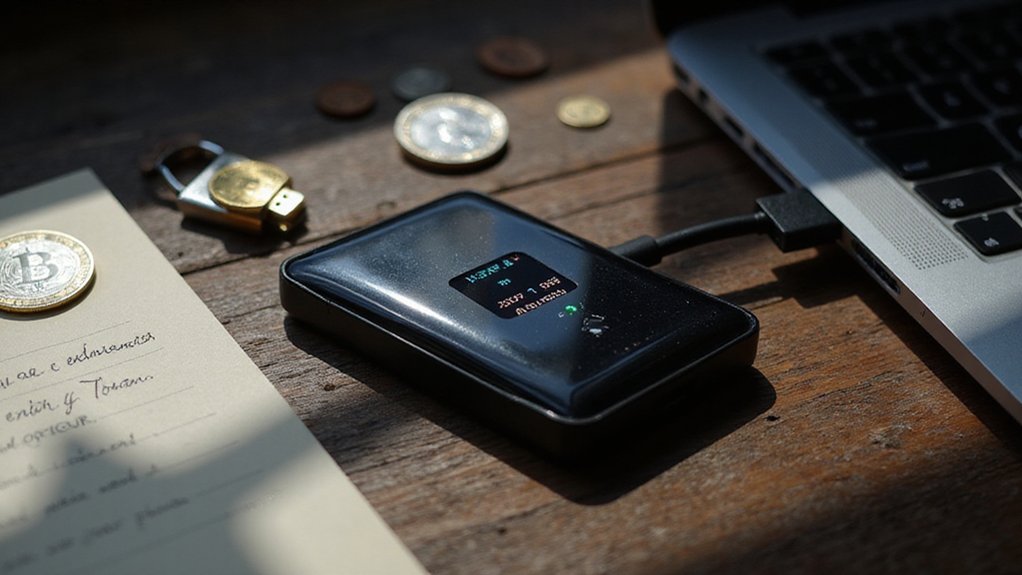Cryptocurrency wallets fall into distinct categories that reflect the eternal tension between security and convenience. Hot wallets like Exodus and MetaMask maintain internet connectivity for seamless transactions but expose users to hacking risks. Cold wallets prioritize security through offline storage, employing hardware encryption and recovery seeds ideal for long-term holdings. Software variants span desktop, mobile, and web applications, while paper wallets offer minimal technological dependence despite practical limitations—each option demanding informed compromises based on individual risk tolerance.

The cryptocurrency ecosystem presents investors with a fundamental paradox: the very technology designed to eliminate trusted intermediaries requires users to make critical trust decisions about where—and how—to store their digital assets.
This irony becomes particularly acute when examining the wallet landscape, where security and convenience exist in perpetual tension.
In cryptocurrency storage, maximum security demands sacrificing convenience, while optimal accessibility inevitably compromises protection—forcing users into uncomfortable compromises.
Hot wallets represent the accessible end of this spectrum, maintaining constant internet connectivity that enables seamless transactions while simultaneously exposing users to cyber threats.
Popular options like Exodus, Trust Wallet, and MetaMask exemplify this trade-off, offering multi-cryptocurrency support and exchange integration at the cost of heightened vulnerability to hacking attempts.
The user experience remains compelling—accessing funds across devices with remarkable ease—yet this convenience comes with inherent risks that many users either underestimate or willfully ignore.
Cold wallets occupy the opposite extreme, prioritizing security through deliberate disconnection from online networks.
Hardware wallets such as Trezor and Ledger exemplify this approach, employing advanced security measures including recovery seeds and hardware encryption to protect private keys.
These physical devices offer compatibility across multiple operating systems and blockchains, making them ideal for long-term storage despite their inconvenience for frequent transactions. These devices function as crypto bridges that connect users to blockchain networks while keeping private keys safely offline.
Software wallets encompass desktop, mobile, and web variants, each presenting unique security profiles.
Desktop wallets like Electrum and MyEtherWallet strike a middle ground between accessibility and protection, while mobile options such as BlueWallet prioritize portability.
Web wallets, often functioning as browser extensions, provide rapid access to blockchain services but increase exposure to malware and phishing attacks.
Paper wallets—physical documents containing private keys and addresses—represent perhaps the most counterintuitive storage method in a digital ecosystem.
While offering minimal technological dependence and low costs, they remain vulnerable to physical damage and prove impractical for regular transactions due to manual key entry requirements. The loss of access to private keys may result in permanent cryptocurrency loss, highlighting the critical importance of secure backup procedures for all storage methods.
The wallet selection process ultimately reflects broader cryptocurrency adoption challenges: balancing innovation with security, convenience with control.
Some wallets differentiate themselves through innovative approaches, such as Zengo’s implementation of keyless security using multi-party computational cryptography to eliminate the need for traditional seed phrases.
Users must navigate this landscape understanding that no solution perfectly reconciles these competing demands, making informed compromises based on individual risk tolerance and usage patterns.
Frequently Asked Questions
Can I Recover My Crypto if I Lose My Wallet’s Private Keys?
Recovering cryptocurrency without private keys proves virtually impossible—a sobering reality that has permanently locked away approximately $140 billion in Bitcoin.
Recovery hinges entirely on possessing either the private key or seed phrase, both serving as cryptographic proof of ownership.
While tools like BTCRecover might salvage partial information through brute-force methods, and social recovery mechanisms exist for the prescient, the blockchain’s immutable design offers no central authority for password resets—unlike conventional banking’s forgiving infrastructure.
How Much Does It Cost to Set up a Crypto Wallet?
Crypto wallet setup costs span a remarkably wide spectrum, from absolutely free software wallets (downloaded instantly) to $49-$169 hardware devices requiring shipping fees.
Those seeking custom applications face substantially steeper expenses—$8,000 minimum for basic functionality, escalating beyond $25,000 for premium features.
Given the previous discussion about private key recovery challenges, one might reasonably question whether the correlation between wallet cost and actual security justifies these dramatic price differentials.
Can One Wallet Store Multiple Types of Cryptocurrencies?
Most modern wallets support multiple cryptocurrencies, with multi-chain capabilities spanning Bitcoin, Ethereum, and various altcoins through a single interface.
Hardware wallets like Ledger devices typically offer the broadest compatibility, while software solutions such as Trust Wallet or MetaMask excel at specific ecosystems.
However, support varies greatly—particularly for newer or niche tokens—requiring users to verify compatibility before commitment, lest they discover their obscure memecoin requires yet another wallet download.
What Happens to My Crypto if the Wallet Company Shuts Down?
When wallet companies shutter operations, the outcome depends entirely on wallet architecture.
Self-custody wallets (like Exodus) preserve user access since private keys remain under individual control—assets can be recovered via seed phrases in compatible wallets.
Hardware wallets similarly protect holdings through recoverable private keys.
However, custodial services present genuine risk: exchange failures can freeze assets indefinitely.
The blockchain persists regardless, but accessing one’s cryptocurrency requires maintaining control over private keys rather than trusting centralized intermediaries.
How Often Should I Backup My Crypto Wallet?
Crypto wallet backup frequency depends entirely on transaction volume and wallet type. Hot wallets require immediate backup after any significant activity, while cold storage might warrant monthly or quarterly updates.
The critical element isn’t frequency but consistency—establishing a routine that captures seed phrases and private keys systematically.
Given that wallet companies can vanish overnight (as previously discussed), treating backup schedules with the same rigor as traditional financial records proves wise, not paranoid.









